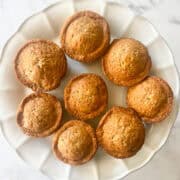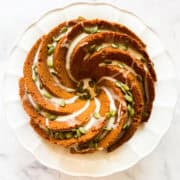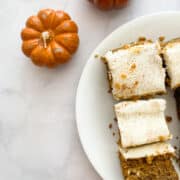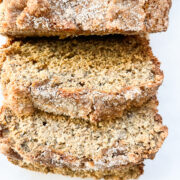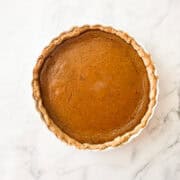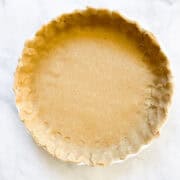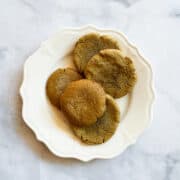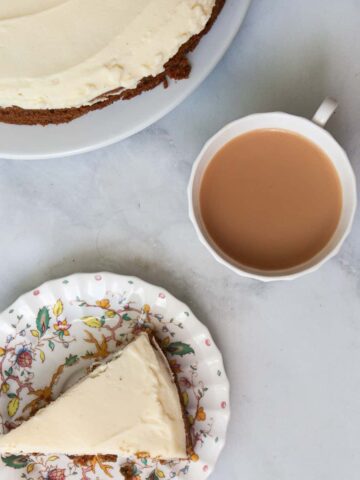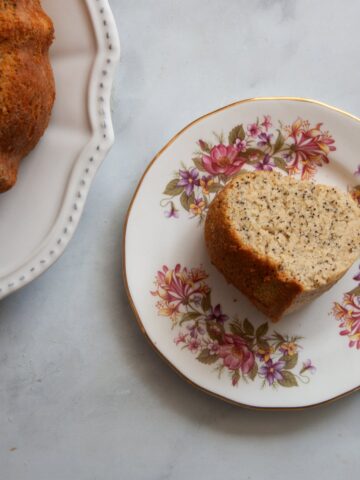There are so many gluten-free flours to choose from, and each bring its own flavor and nutritional profile. I love to combine different flours, and tend to choose a specific flour based on the other flavors I'll incorporate in a recipe. Thus, a gluten-free flour guide!
When you need to substitute one flour for another, I'll give suggestions per recipe based on the original flour called for. But of course you can also experiment based on your personal tastes and preferences.
If you'd like to convert a traditional recipe to gluten-free, a good ratio of substitution for flours is:
70% wholegrain flours (1-3 different flours) to 30% starch (1-2 different flours)
I've linked to my favorite flours in the lists below -- I really like Bob's Red Mill and Anthony's products for quality, consistency, and relative affordability. I can find many naturally gluten-free flours at my local grocery stores, and they're always available online.
Here's a brief gluten-free flour guide to jumpstart you on learning about gluten-free flours - happy baking!
Whole Grain Gluten-Free Flours
My favorite types of gluten-free flours are whole grain flours (side note: when I bake with regular flour I always like to incorporate whole wheat or whole grain flours, like spelt, too. I love the extra nutritional hit and flavor profile we receive from whole grain flours.). It is rare that I will call for white rice flour in my recipes, although it does happen on occasion.
<< See the FAQ for the types of gluten-free flours you'll need to make the recipes on this site >>
Whole grain gluten-free flours include oat flour (as noted, my favorite gluten-free flour), sorghum flour, teff flour, millet flour, buckwheat and quinoa flours (both of these technically are considered seeds), amaranth flour, and brown rice flour (which I don't use). Read on for more about these unique gluten-free whole grain flours.
Oat Flour -- My absolute favorite naturally gluten-free flour, oat flour is made from rolled oats that are finely ground into flour. It's so easy and economical to DIY your own oat flour, just give oats a good grind in the food processor. If you are sensitive, make sure to buy certified gluten-free oats or oat flour. Oats are high in protein, fiber, and magnesium, which make them a nutritional favorite. But I also love them for their versatility and light buttery flavor, which brings such a delicious undertone to any baked good made with oat flour.
Sorghum Flour -- High in fiber and protein and a good source of antioxidants, sorghum flour is a wonderful naturally gluten-free flour. It is a great substitute for oat flour if you can't eat oats; try it interchangeably in all of the recipes on Cucina Nicolina that call for out flour.
Teff Flour -- Another nutritional powerhouse, teff flour is a protein-packed naturally gluten-free flour. You can use ivory teff flour if you want your baked goods to turn out a bit lighter in color than when you use regular teff flour. Teff is also a good source of iron, calcium, fiber, and Vitamin C.
Millet Flour -- Made from finely ground millet grains, millet flour is high in fiber, niacin, beta-carotene, Vitamins A and B, potassium, iron, calcium, and antioxidants. It has a subtle flavor and adds a lovely buttery color to baked goods.
Buckwheat Flour -- Buckwheat flour has a very distinctive flavor that's often described as "earthy" or robust. It's lovely balanced with almond flour and is high in protein, fiber, and antioxidants.
Quinoa Flour -- I make quinoa at least once a week to eat with stir fries and I naturally love quinoa flour too! It is high in protein and is great included in recipes that have bolder flavors, such as with chocolate or bananas. If you find quinoa to be bitter, toast the flour or quinoa beforehand. Quinoa flour can be easily made at home using a high speed blender to pulverize toasted quinoa into a fine powder.
Amaranth Flour -- Amaranth is a naturally gluten-free flour made from ground amaranth grains. It is high in protein, fiber, micronutrients and antioxidants and brings a nutty undertone when used in baking.
Brown Rice Flour -- Brown rice flour is a starchier whole grain naturally gluten-free flour that is often found in gluten-free baking recipes. I prefer to use other whole grain flours in my baking because I eat brown rice in my savory meals and don't want to overdo it as brown rice contains higher levels of arsenic.
White Rice Flour -- White rice flour, although not a whole grain flour, a very versatile, neutral flour that's on the starchier side. I don't use it a lot in my baking but it does have its place.
Starchy Gluten-Free Flours
When creating a homemade gluten-free flour mix or translating a favorite recipe to be gluten-free, it's important to have the proper balance of whole grain or nut flours to starchy flours for the ultimate in gluten-free baking success. Starches like sweet white rice flour also act as a binder in gluten-free baking so there's no need to add xanthan gum.
<< Why don't I use xanthan gum in my gluten-free recipes? >>
Learn more about starchy gluten-free flours:
Sweet White Rice Flour -- Sweet white rice flour, or glutinous rice flour (note: it's gluten-free!), is amazing in gluten-free baking recipes as it works as a binder with other gluten-free flours to create wonderful structure and flavor, no xanthan gum required. Sweet white rice flour is also known as mochiko, and makes the delicious Japanese mochi, and it is high in starch. This flour is a must for gluten-free baking.
Tapioca Flour -- Tapioca flour, which is made from the dried root of the cassava plant (it differs from cassava flour in that it is extracted from the starch of the cassava root while cassava flour is made from the entire root). Tapioca flour, like sweet white rice flour, is essential to gluten-free baking as it creates a light, fluffy texture while helping to bind the other gluten-free flours together in the recipe.
Potato Starch -- NOT potato flour, potato starch is the extracted and dried starch from potatoes. Potato starch works similarly to tapioca flour, and can be used alongside tapioca flour to balance and lighten recipes. I don't use potato starch often, but it will show up in some recipes.
Arrowroot Flour -- Also known as arrowroot starch or powder, arrowroot powder is another gluten-free starchy flour extracted from tubers. It contains a good amount of potassium, iron and B vitamins, and is grain-free, which will suit many. It is used as a thickener and binder in gluten-free recipes.
Nut Flours
Nut flours are exactly what their name states -- flours made from nuts.
Almond Flour -- A staple in gluten-free baking, almond flour is high in protein (also fat, but it's considered more of a "healthy" fat). Almond flour is made from finely ground almonds and I use almond flour rather than almond meal in my recipes. Almond flour brings moisture, structure, and texture to gluten-free baking.
Tiger Nut Flour -- If you can't tolerate almonds, tiger nut flour is a good alternative as it performs like almond flour. Tiger nut flour is actually not made from nuts but from dried, ground tubers and is low in carbohydrates.
Coconut Flour -- Coconut flour is a fine, soft powder made by grinding dried coconut meat into flour. It's important to note that coconut flour performs very differently from other flours and is very absorbent. So if you wish to substitute it for another flour in a recipe you may end up with poor results. It's best to make recipes that are specifically designed to incorporate coconut flour.
Chestnut Flour -- Popular in Europe and especially Italy, chestnut flour is made from ground chestnuts. The flour has a sweet undertone that nicely complements baked goods. I consider chestnut flour to be a specialty flour and don't use it in my baking.
Other nuts - hazelnut, walnut, pistachio, etc. -- These nuts may be treated similarly to almond flour in recipes, though of course if you substitute hazelnut flour for almond flour, for example, the flavor of your bake will change. Always buy or make your nut flours as finely ground as possible (more of a "flour" than a "meal").

